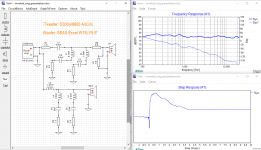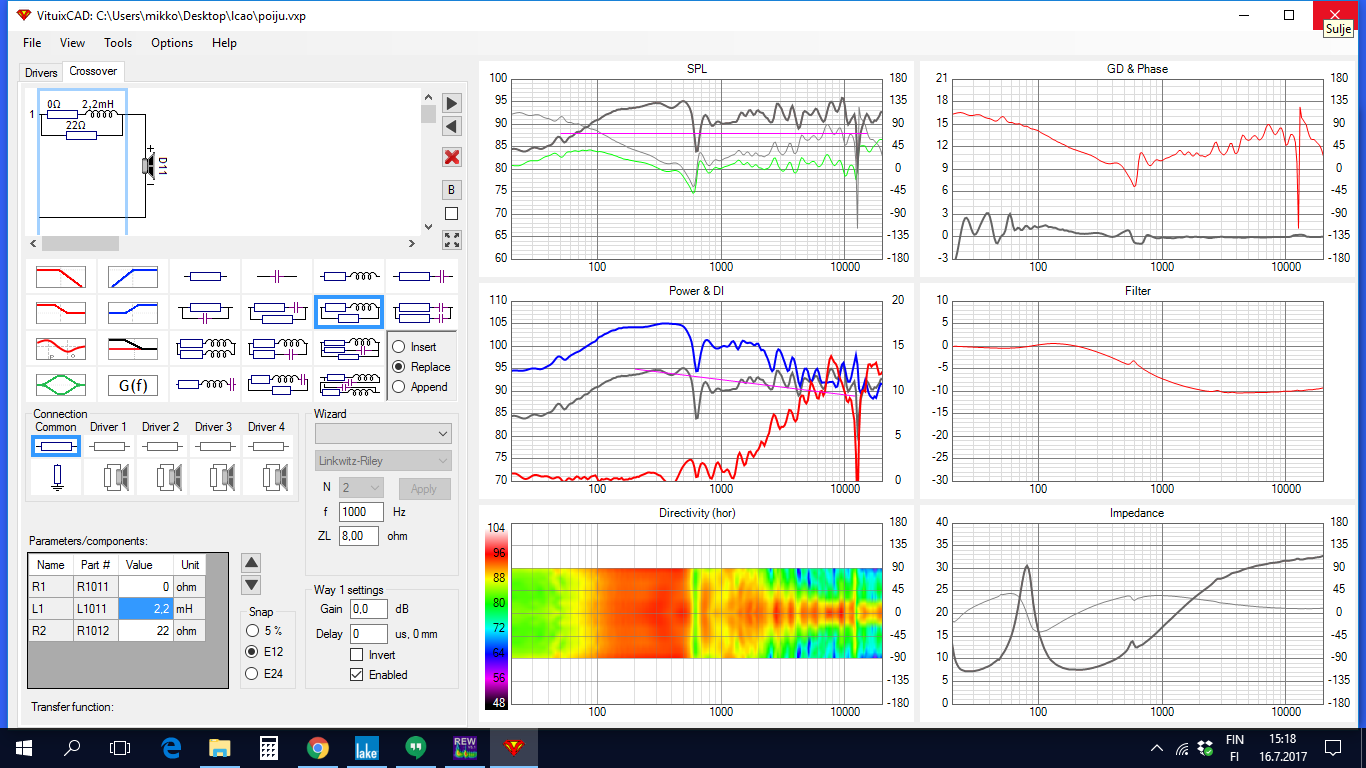If there ears can detect this, then it should make a difference and therefore having 0 phase shift is a good thing. There are studies that seem to suggest the ears can detect this.
And there are also studies that suggest the ears can’t detect the phase shift. I attached an article by Art Ludwig that presents a balanced argument for both the pro and con sides of phase shift audibility. It also includes references to some of the scientific studies performed in this area. A very good read.
I do think the whole linear phase topic is popular now simply because it’s easy to implement via DSP. I personally place the topics kimmosto pointed out in post #176 above the importance of linear phase.
Here are quotes from two individuals whose opinions I respect:
From Dr. Floyd Toole, when he was still at Harmon International:
"It turns out that, within very generous tolerances, humans are insensitive to phase shifts. Under carefully contrived circumstances, special signals auditioned in anechoic conditions, or through headphones, people have heard slight differences. However, even these limited results have failed to provide clear evidence of a 'preference' for a lack of phase shift. When auditioned in real rooms, these differences disappear.”
And from John Kreskovsky (john k here). In the early 2000’s John became enamored (some might say obsessed 😀) with transient perfect (TP) passive crossovers. At the time he wrote an article titled “It’s just a Phase I’m Going Through” that detailed why he thought TP crossovers were superior. He then went on to publish several different passive TP crossover designs. Time rolled on and linear phase DSP entered the scene. Here’s a post that he then made back in 2012:
“As you well know I used to be a very strong advocate of TP design. I could swear I could hear differences with could only be attributable to TP design. The problem today is that with codes like the Phase Arbitrator and the Bodzio UE I can correct any system to be linear phase while leaving everything else un altered (axial response, vertical and horizontal polar, power response...). And I can rapidly switch back and fourth between linear and nonlinear phase. The results I have found in doing so are that only on very limited material and under very limited conditions can I detect a difference between TP and nonTP systems. I am forced to conclude that ultimately the differences I used to hear had more to do with differing power or polar response than TP vs non TP.”
I think this topic will be debated endlessly. Everyone will decide what's important to them and move on.
Attachments
Has anyone compared the difference in sound using FIR vs. IIR in DSP?
FIR can give you linear phase whereas IIR phase shift cannot be controlled. And of course the reason using FIR is because you can control the phase shift (linear phase …).
FIR can give you linear phase whereas IIR phase shift cannot be controlled. And of course the reason using FIR is because you can control the phase shift (linear phase …).
Has anyone compared the difference in sound using FIR vs. IIR in DSP?
FIR can give you linear phase whereas IIR phase shift cannot be controlled. And of course the reason using FIR is because you can control the phase shift (linear phase …).
i have, but i´ve been using fir cause drivers has had some problems so i´ve needed that sharp cut.
cant tell much difference between lr4 and fir. i might have few rew files from those days when i jumped those xo´s
i have, but i´ve been using fir cause drivers has had some problems so i´ve needed that sharp cut.
cant tell much difference between lr4 and fir. i might have few rew files from those days when i jumped those xo´s
Please correct if I am wrong, but comparing lr4 and FIR is comparing analog lr4 and FIR? Or you were using IIR for the LR4?
This post is probably for John K. since it seems like he has done some of these works before. So if one were to use FIR to correct for the phase shift, is this what one would do?
1. First, obtain the freq and phase plot of your existing speaker. For example, for a two way, you have a phase shift of 180 degree at 20KHz.
2. Let's call the existing response as E(jw) and angle(E) - magnitude and phase.
3. Let's say you want your target response, T, is to have the same magnitude of E(jw) but the phase shift is 0.
4. Let's call the correction FIR filter as F. You want to find F. So you have E * F = T. Therefore, F = T/E. In this case, the magnitude of T(jw) and E(jw) would be the same. The only difference is the phase.
5. Since the magnitude is the same for E and T, I suspect F will have similar affect of a All Pass filter but only the phase get modified. Is this correct?
6. Once you got F in freq. and phase, you then calculate the impulse response of F by using Inverse FFT correct? Then you would convolve the music file, .WAV, with the impulse of F before sending them to your speakers?
My next question is:
1. What software tool is use to find F? Is it rePhrase or something else?
2. Assume you found F, what software to use to convolve the F before sending the stream to your DAC?
3. How do you measure the overall response with F in place? For example, if I use ARTA, it will not have the ability to convolve with F, which means F will be bypassed so you can't measure how your system responds with F in place.
1. First, obtain the freq and phase plot of your existing speaker. For example, for a two way, you have a phase shift of 180 degree at 20KHz.
2. Let's call the existing response as E(jw) and angle(E) - magnitude and phase.
3. Let's say you want your target response, T, is to have the same magnitude of E(jw) but the phase shift is 0.
4. Let's call the correction FIR filter as F. You want to find F. So you have E * F = T. Therefore, F = T/E. In this case, the magnitude of T(jw) and E(jw) would be the same. The only difference is the phase.
5. Since the magnitude is the same for E and T, I suspect F will have similar affect of a All Pass filter but only the phase get modified. Is this correct?
6. Once you got F in freq. and phase, you then calculate the impulse response of F by using Inverse FFT correct? Then you would convolve the music file, .WAV, with the impulse of F before sending them to your speakers?
My next question is:
1. What software tool is use to find F? Is it rePhrase or something else?
2. Assume you found F, what software to use to convolve the F before sending the stream to your DAC?
3. How do you measure the overall response with F in place? For example, if I use ARTA, it will not have the ability to convolve with F, which means F will be bypassed so you can't measure how your system responds with F in place.
Last edited:
hmmm, I think the tweeter is out of phase.
I've seen 6db this way, can't figure why.
Maybe measures flatter if not time aligned (acoustic centers).
2 notches per driver ?
eek
You can notch it flat, but a harmonic under it will still cause the resonance to go off, you will still hear it. So even with a 4khz notch, 2khz on the driver will cause the driver to ring at 4khz.......
a 6db crossover is rough.
Ideally you are freq flat 2 octaves outside of crossover point.
Otherwise the driver rolls 6db first octave then 12 db (due to a driver naturally rolling off and the phase rotates more), you are out of alignment again.
And passively, you better have a flat impedance, or maybe zobel it.
Don't forget to deal with the Z-spike on the tweet at Fs.
Is this a deal breaker ?
idk.
I've seen 6db this way, can't figure why.
Maybe measures flatter if not time aligned (acoustic centers).
2 notches per driver ?
eek
You can notch it flat, but a harmonic under it will still cause the resonance to go off, you will still hear it. So even with a 4khz notch, 2khz on the driver will cause the driver to ring at 4khz.......
a 6db crossover is rough.
Ideally you are freq flat 2 octaves outside of crossover point.
Otherwise the driver rolls 6db first octave then 12 db (due to a driver naturally rolling off and the phase rotates more), you are out of alignment again.
And passively, you better have a flat impedance, or maybe zobel it.
Don't forget to deal with the Z-spike on the tweet at Fs.
Is this a deal breaker ?
idk.
Last edited:
Neat thread - only found it now.
One way to do 1st order is to not use a dome tweeter but a wideband full range like ScanSpeak 10F/8424 with a very wideband woofer.
10F/8424 & RS225-8 FAST / WAW Ref Monitor
Like this:
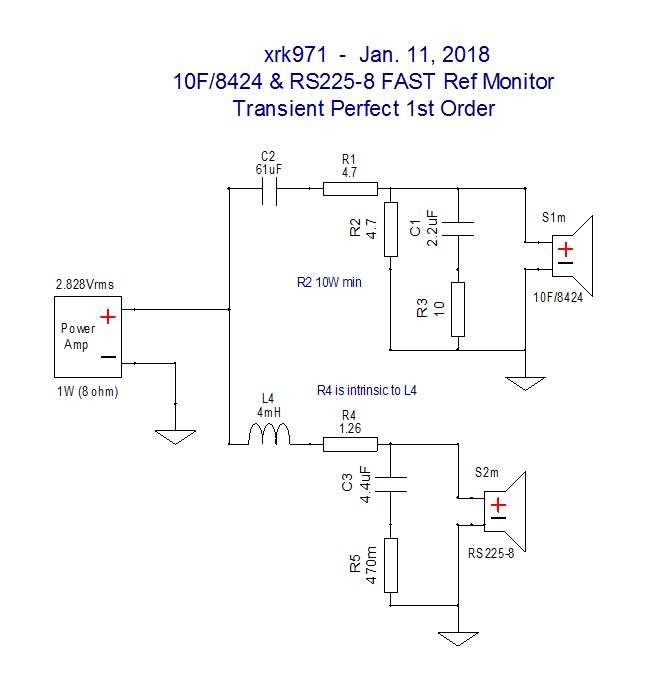
Predicted XO response:
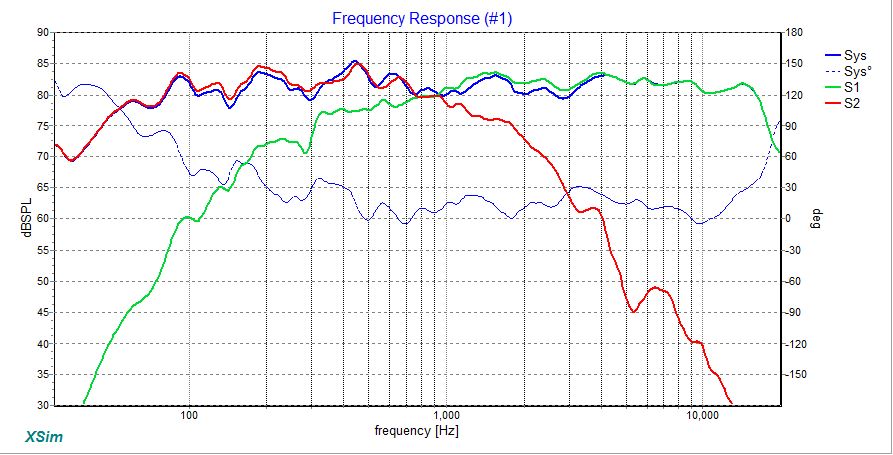
Here is measured frequency response and phase:
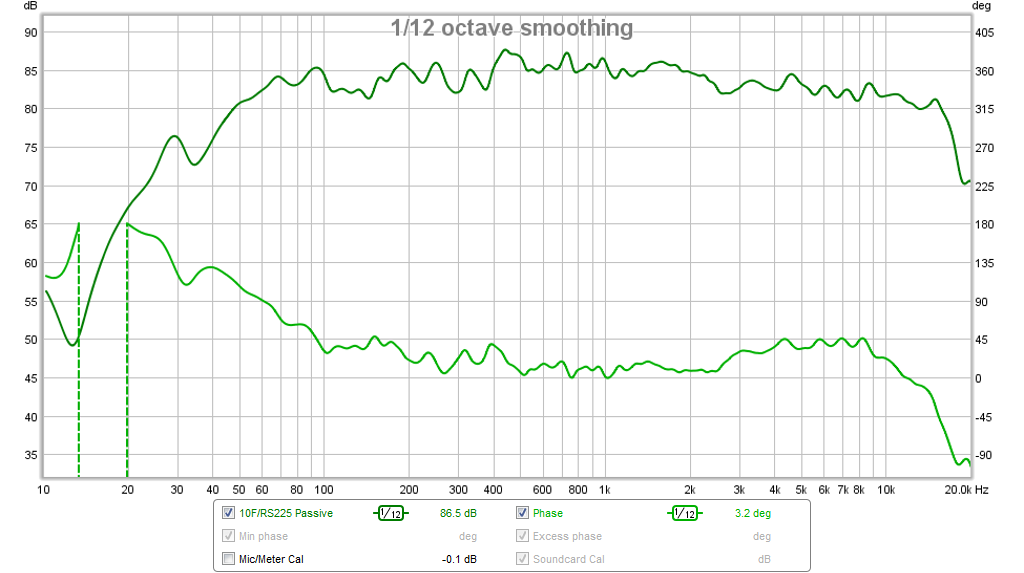
Here is measured step response:
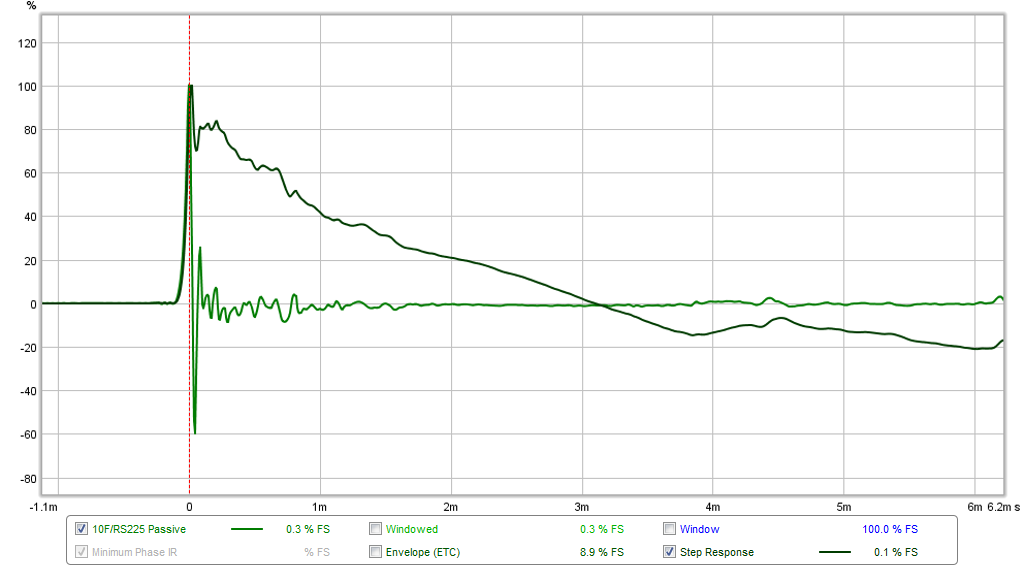
One way to do 1st order is to not use a dome tweeter but a wideband full range like ScanSpeak 10F/8424 with a very wideband woofer.
10F/8424 & RS225-8 FAST / WAW Ref Monitor
Like this:
Predicted XO response:
Here is measured frequency response and phase:

Here is measured step response:

Last edited:
xrk971 - crossover is nice 'n low. Part of the "FR" driver schemes, as I run currently - with crossover also nice 'n low. So with a dome tweeter, crossover is nice 'n high. Could it be the spectral portion where the crossover is happening - and associated phase anomalies introduced in that approach - that can be heard? At least, heard easier than at < 1KHz.
I'd like to hear the speaker system that you posted. I bet it sounds good to my ears!
I'd like to hear the speaker system that you posted. I bet it sounds good to my ears!
It does indeed sound good. My go to speaker for past 3 years and I have many. It’s not hard to make or expensive. The TL version goes quite low.
I have been entertaining it.
You, bob brines, etc.
I see a full range driver, but want more dispersion.
I see a full range driver, but want more bass.
I played with 3",2x4", 4x4" focused, 9x4" focused, 8" (still have), 12" full range drivers.
I've had thiel model 4a and cs2.
So I am a fan of step response, or time alignment / phase alignment.
The more I read Mr. Dunlavy posts, the more I realize there are good sounding speakers, bad sounding speakers, and accurate speakers...... If a cd player / amp couldn't pass a square wave, you wouldn't buy it, so why would you buy a speaker that cannot reproduce it (within constraints) ?
You, bob brines, etc.
I see a full range driver, but want more dispersion.
I see a full range driver, but want more bass.
I played with 3",2x4", 4x4" focused, 9x4" focused, 8" (still have), 12" full range drivers.
I've had thiel model 4a and cs2.
So I am a fan of step response, or time alignment / phase alignment.
The more I read Mr. Dunlavy posts, the more I realize there are good sounding speakers, bad sounding speakers, and accurate speakers...... If a cd player / amp couldn't pass a square wave, you wouldn't buy it, so why would you buy a speaker that cannot reproduce it (within constraints) ?
Last edited:
@Manninen: is your Vituixcad sim based on 5 degree+dual channel measurements of the L.cao.f6 out to 90 degrees, as recommended by Kimmosto?
Well, I beg to differ. Especially with the sometimes weird break up patterns of FR drivers, pistonic extrapolation of on axis curves may lead to a somewhat flattering Directivity Index.

well if you want to go that exact ima gona tel you a stoory apaut disainin that kurrent krossover.
i didn´t have impedance measuring device at that time. i took measure raw driver on the box and measure with parts which came with driver. took some drivers impedance curves from internet which came closest to curve with those parts i had.
yes im aware of most exact database to make best simulations.
enclosure is plastic buoy with allsorts of problems, even driver has its own problems.
no matter how exact i do things does not change that thing 6.5" fr beams after 2k.
still happy with these, when wanking with my main 4-way its good to reset your head with this speaker.
Last edited:
Yes, something that just works while your main speaker gives you a headache. I've had a few of those 😉
If I understood him correctly he was using FIR correction before the crossover. This way he could switch back and forth between transient-perfect and "normal". This way no other properties of the system were changed for the listening test.
When I find the time I will do something different: I willl use a transient-perfcet crossover and switch an allpass in and out before the crossover in order to hear whether it makes any difference. The test will be purely subjective of course but the decision whether I like a topology or not is also a purely subjective one.
Regards
Charles
It would be very interesting to see the outcome of this test.
Has anyone compared the difference in sound using FIR vs. IIR in DSP?
FIR can give you linear phase whereas IIR phase shift cannot be controlled. And of course the reason using FIR is because you can control the phase shift (linear phase …).
I just did something close to this. I drove my PAP Trios with the post amp crossover, and corrected the approx 90 degree phase shift of that cross using FIR. I can switch that in and out with all else equal.
I found the FIR could predictably correct measured crossover phase resulting in flat phase up to about 7khz, after which the tangband w8-1808 phase perturbations could not be predictably fixed.
Switching the FIR in and out does sound different.That said, I don’t instantly feel it’s “better”.
- Home
- Loudspeakers
- Multi-Way
- An exercise in converting a speaker to time-phase coherent
